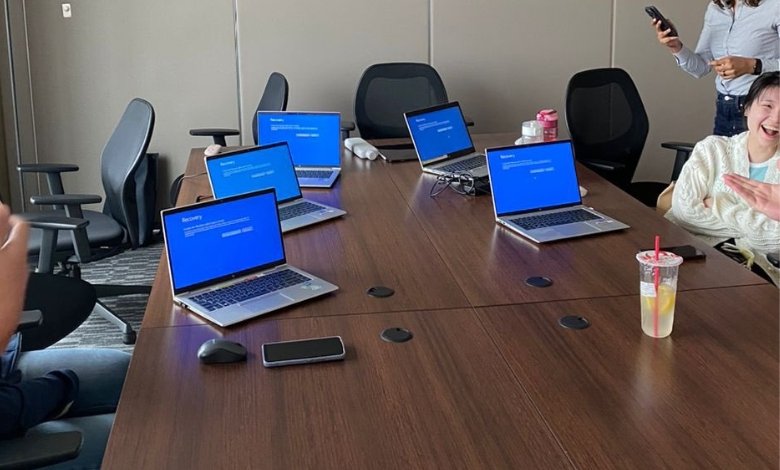Global Cyber Outage Causes Major Disruptions Across Multiple Sectors
Swift Response and Mitigation Efforts Underway

Faulty CrowdStrike Update Triggers Widespread Issues
A recent Global cyber outage has sent shockwaves across the globe, severely affecting various sectors such as banking, airlines, and media. This unprecedented disruption has been traced back to a faulty update from the renowned cybersecurity provider, CrowdStrike. The update has inadvertently caused widespread issues, including the dreaded Blue Screen of Death (BSOD) on numerous Windows machines, crippling operations and services worldwide.
The Source of the Problem
CrowdStrike, a leading cybersecurity firm known for its cutting-edge solutions and comprehensive protection, issued an update aimed at enhancing its security features. However, the update contained a critical flaw that triggered a cascade of malfunctions. The BSOD error, a notorious Windows system failure indicator, appeared on thousands of machines, rendering them inoperable and causing panic among IT departments and users alike.
Immediate Impact on Key Sectors
The ramifications of this cyber outage have been felt deeply across several key sectors:
Banking
Banks worldwide faced significant operational challenges as their systems went offline. ATM networks were disrupted, online banking services were suspended, and many financial transactions were left in limbo. Customers were unable to access their accounts or perform essential banking activities, leading to frustration and a loss of confidence in digital banking platforms. Financial institutions scrambled to restore services and assure their customers that their data remained secure despite the outage.
Airlines
The aviation industry was hit particularly hard, with numerous airlines grounding flights due to system failures. Check-in systems, flight scheduling, and communication networks were all affected, causing widespread delays and cancellations. Passengers were left stranded at airports, facing long waits and uncertainty about their travel plans. The chaos at major international hubs underscored the critical dependency of modern air travel on reliable IT infrastructure.
Media
Media companies also experienced severe disruptions as their networks and broadcasting systems were compromised. Newsrooms struggled to deliver timely updates, and live broadcasts were interrupted. The ability to report on the unfolding crisis was hampered, creating a paradox where the media itself became a victim of the very news it was trying to cover.
Global Efforts to Mitigate the Crisis
In response to the outage, affected companies and organizations have mobilized their IT teams to diagnose and resolve the issue. CrowdStrike, acknowledging the gravity of the situation, has deployed a fix to rectify the faulty update. Their engineers are working around the clock to ensure the update is applied swiftly and effectively, aiming to restore normalcy as soon as possible.
Steps Taken by Affected Organisations
- Emergency Response Teams: Many organisations have activated their emergency response protocols. IT departments are collaborating with CrowdStrike to implement the fix and bring systems back online.
- Communication with Stakeholders: Transparent communication has been a priority. Companies have issued statements to inform customers, employees, and shareholders about the outage, its impact, and the steps being taken to address it.
- Data Protection Measures: Ensuring data integrity and security has been paramount. Organizations are conducting thorough assessments to confirm that no data breaches have occurred during the outage.
CrowdStrike’s Response and Future Precautions
CrowdStrike has taken full responsibility for the incident, emphasising their commitment to rectifying the situation. The company’s CEO issued a public apology, highlighting the steps being taken to prevent such occurrences in the future. These measures include:
- Enhanced Quality Assurance: CrowdStrike is overhauling its quality assurance processes to ensure more rigorous testing of updates before they are released.
- Improved Incident Response: The company is strengthening its incident response capabilities to react more swiftly and effectively to any future issues.
- Customer Support: Additional resources are being allocated to customer support teams to assist affected clients in implementing the fix and restoring their systems.
Broader Implications for Cybersecurity
This incident has underscored the vulnerabilities inherent in digital infrastructure and the critical role of cybersecurity providers. It serves as a stark reminder of the importance of robust cybersecurity measures and the potential consequences of even a minor flaw in security updates.
Lessons Learned
- Redundancy and Backup Systems: Organizations must ensure they have robust backup systems and redundant pathways to maintain operations during outages.
- Comprehensive Testing: Cybersecurity providers must adopt comprehensive testing protocols to identify and mitigate potential issues before updates are deployed.
- Collaborative Efforts: There is a need for greater collaboration between cybersecurity firms, industry stakeholders, and regulatory bodies to develop more resilient cybersecurity frameworks.
Moving Forward
As the global community grapples with the aftermath of this cyber outage, there is a renewed focus on enhancing cybersecurity resilience. Companies are re-evaluating their IT strategies, investing in more sophisticated security solutions, and strengthening their disaster recovery plans. This incident, while disruptive, has also spurred innovation and a collective effort to build a more secure digital future.
Conclusion
The global cyber outage triggered by a faulty update from CrowdStrike has highlighted the interconnectedness of our digital world and the critical importance of robust cybersecurity measures. While the immediate focus is on resolving the current crisis, the long-term implications will likely drive significant advancements in cybersecurity practices and policies. As affected sectors work tirelessly to restore services and regain stability, this incident serves as a crucial learning experience for the entire digital ecosystem.